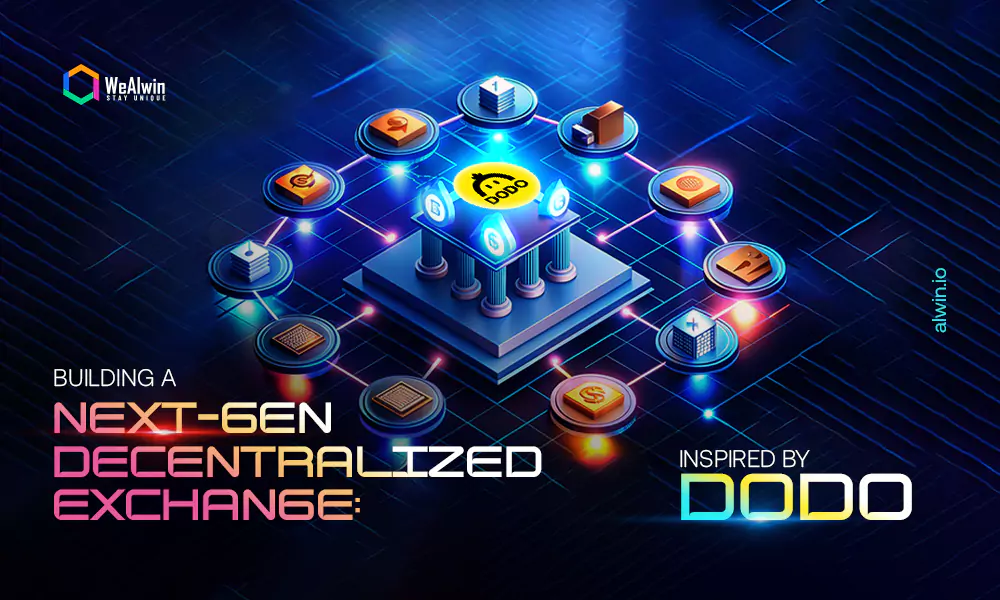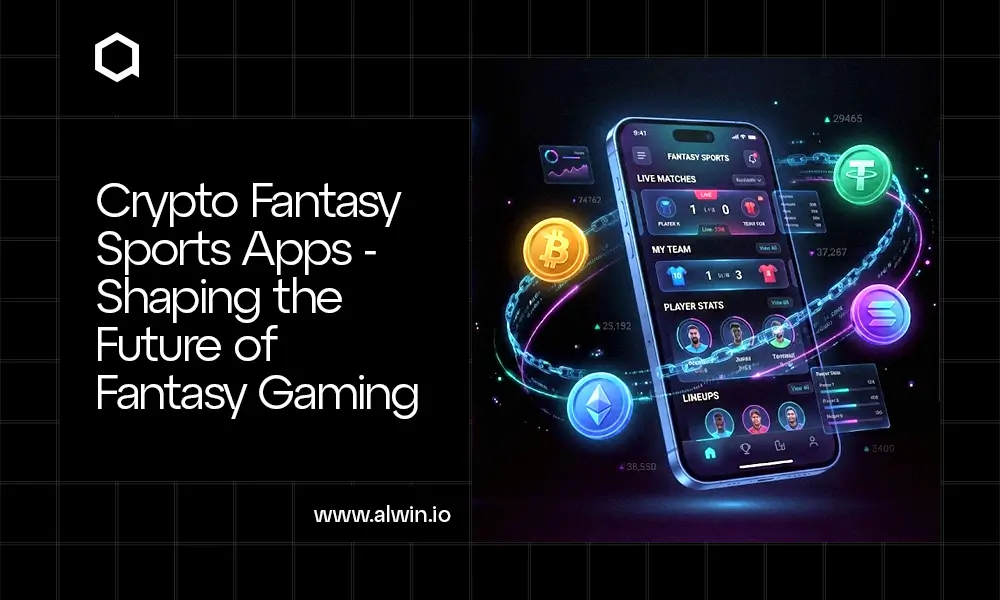We are in a transformative age where digital currencies allow us to buy and sell goods and services like traditional fiat currencies. To trade this digital money, we use crypto exchanges, which can be centralized or decentralized.
Decentralized exchanges (DEXs) have gained popularity and now account for about 55% of the total on-chain trading volume in the cryptocurrency market, signaling a strong shift toward decentralized solutions mainly for their secure and user-focused trading experience.
With DEXs, users can trade tokens directly from their wallets, ensuring better security and true ownership of their assets.
DODO stands out among DEXs with its innovative Market-making strategies. This platform enhances trading efficiency and supports new crypto projects with a free ICO listing through its Initial DODO Offerings (IDOs).
For those interested in creating their own trading platform, with our industry-leading decentralized exchange software development you can easily integrate features similar to DODO, enabling a competitive trading environment.
What is DODO?
DODO is a decentralized finance (DeFi) protocol and on-chain liquidity provider based in China. It distinguishes itself from traditional Automated Market Makers (AMMs) with its unique Proactive Market Maker (PMM) algorithm.
The PMM algorithm enhances the liquidity and price stability of digital assets. It then provides liquidity close to these prices, stabilizing liquidity provider portfolios, reducing price slippage, and mitigating impermanent loss. This model also facilitates arbitrage trading as a reward, further enhancing its efficiency.
Key differences between DODO's PMM and traditional AMMs:
- Dynamic Pricing
- Proactive Liquidity Provision
- Improved Capital Efficiency
- Reduced Slippage
In addition, DODO supports new crypto projects through its Initial DODO Offering (IDO), allowing issuers to list their tokens for free. DODO’s smart contract operates as an ERC20 token on the Ethereum network.
Unique Features of DODO-Inspired Decentralized Exchange
Proactive Market Maker (PMM)
At the core of DODO's success is its unique Proactive Market Maker (PMM) algorithm, which is a game-changer in the decentralized exchange landscape.
Unlike traditional Automated Market Makers (AMMs), the PMM mimics human trading behavior by utilizing oracles to gather accurate market prices for assets. This allows DODO to provide ample liquidity close to these prices, stabilizing liquidity providers' portfolios and reducing price slippage.
- Dynamic Liquidity Provision: The PMM algorithm focuses liquidity around the market price, reducing slippage and improving the trading experience.
- Reduced Impermanent Loss: The PMM design shields liquidity providers from price volatility, making it a safer choice for those supplying liquidity.
Crowdpooling and Initial DODO Offerings (IDOs)
One of the standout features of DODO is its crowd-pooling mechanism. This process allows projects to distribute tokens fairly while ensuring liquidity from the outset. By preventing front-running and bot interference, crowd pooling creates a level playing field for all participants.
The benefits of crowd pooling are significant:
- Equal Opportunity Distribution: All participants have a fair shot at acquiring tokens, removing the edge automated trading bots might have.
- Simplified Token Launches: Issuers just need to deposit their own tokens to set up a liquidity pool, simplifying the process for new projects.
Cross-Chain Capabilities
DODO's support for multiple blockchains, including Ethereum and Binance Smart Chain, is another feature that is crucial for its success. This multi-chain capability enhances accessibility and liquidity, which is vital in today’s diverse crypto landscape.
- Broader User Access: Traders can use DODO across multiple networks, broadening the user base and boosting trading activity.
- Enhanced Liquidity: DODO's multi-chain operation aggregates liquidity from various sources, improving the trading experience.
SmartTrade: Trading and Aggregation Engine
Lastly, DODO's SmartTrade feature serves as a powerful trading and aggregation engine that I consider essential for maximizing trading efficiency. It intelligently routes trades to find the best prices across various liquidity sources, ensuring that users receive optimal trading conditions.
- Price Aggregation: By sourcing prices from multiple DEXs, SmartTrade minimizes slippage and maximizes returns for users.
- User-Friendly Experience: The intuitive interface allows users to execute trades quickly and efficiently, making it accessible even for those new to decentralized trading.
Core Components of a DODO-Like DEX
Architecture of DODO Exchange
Building a DODO-like decentralized exchange (DEX) requires a robust technical architecture that supports its unique features. At the foundation are smart contracts, which automate trading, liquidity provision, and the Proactive Market Maker (PMM) algorithm. These contracts are deployed on blockchain networks like Ethereum and Binance Smart Chain, enabling secure and transparent transactions.
- Liquidity Pools: These pools store assets and enable users to swap tokens directly from their wallets.
- PMM Algorithm: This algorithm adjusts asset pricing dynamically based on market conditions, enhancing liquidity and minimizing slippage.
- User Interface (UI): An intuitive UI is crucial for improving user experience and facilitating easy navigation.
- Cross-Chain Functionality: Supporting multiple blockchains allows users to trade across different networks, boosting liquidity and accessibility.
Security Measures
Security is critical in the DeFi space, and implementing robust security protocols is essential to protect users and their funds.
- Smart Contract Audits: Regular audits by trusted security firms identify vulnerabilities and ensure proper functionality.
- Multi-Signature Wallets: Using multi-signature wallets enhances security by requiring multiple approvals for transactions.
- User Education: Offering resources on safe trading practices empowers users to protect their assets.
- Bug Bounty Programs: Inviting ethical hackers to report vulnerabilities helps strengthen platform security.
Steps to Develop a Decentralized Exchange Like DODO

STEP 1: Defining a Clear Vision and Roadmap
Before you start development, establish a strategic plan that outlines your goals, target audience, and key features.
A clear vision helps guide your project, ensuring that your team remains aligned and focused on delivering a successful decentralized exchange.
STEP 2: Selecting the Technology Stack
Choose the right technology stack to build your DEX. Recommended technologies include:
- Blockchain Platforms: Use Ethereum and Binance Smart Chain for deploying smart contracts.
- Programming Languages: Opt for Solidity for smart contracts and JavaScript or React for the front-end interface.
Database Solutions: Consider IPFS or other decentralized storage solutions for managing off-chain data.
STEP 3: Developing Smart Contracts
When you create smart contracts, keep these key considerations in mind
- Security: Implement best practices to prevent vulnerabilities, such as reentrancy attacks.
- Efficiency: Optimize contracts for gas usage to minimize transaction costs for users.
- Testing: Conduct thorough testing, including unit tests and integration tests, to ensure everything functions correctly.
STEP 4: User Interface Development
Design an intuitive user interface to enhance user adoption. Follow these tips for UI development
- Simplicity: Keep the design clean and straightforward to improve usability.
- Accessibility: Ensure the platform is easy to navigate for both experienced and novice users.
- Responsive Design: Optimize the interface for various devices, including desktops and mobile.
Schedule a Call with Our Experts to Develop Your Own DODO-Inspired Decentralized Exchange Chat with us on WhatsApp
STEP 5: Integrating Multi-Chain Functionality
Enable cross-chain trading and liquidity by following these steps
- Bridge Solutions: Implement cross-chain bridges to facilitate asset transfers between different blockchains.
- Liquidity Aggregation: Use liquidity aggregation protocols to pool resources from multiple chains, enhancing trading opportunities.
STEP 6: Ensuring Security and Compliance
Address regulatory considerations and security best practices by
- Conducting Regular Audits: Engage reputable firms to audit your smart contracts and identify potential vulnerabilities.
- Compliance: Stay informed about regulatory requirements in the jurisdictions where you operate.
STEP 7: Testing and Launching
Prioritize rigorous testing before going live. Focus on
- Functional Testing: Ensure all features work as intended.
- User Acceptance Testing (UAT): Gather feedback from real users to identify areas for improvement.
- Launch Strategy: Prepare a marketing plan to attract users upon launch.
STEP 8: Continuous Improvement and Upgrades
After launch, focus on ongoing enhancements by
- Monitoring Performance: Use analytics to track user engagement and identify bottlenecks.
- User Feedback: Regularly solicit feedback to inform future updates and features.
- Staying Current: Keep up with industry trends and technological advancements to ensure your DEX remains competitive.
DODO Token and Its Ecosystem
The DODO token ($DODO) is essential to the DODO decentralized exchange ecosystem.
As a governance token, it allows holders to vote on proposals, known as DODO Improvement Proposals (DIPs). The token also provides access to Initial DODO Offerings (IDOs) and crowd-pooling investments.
DODO's tokenomics incentivize community participation and liquidity provision. The total supply of $DODO is capped at 1 billion tokens, with 60% allocated for community incentives.
Liquidity providers earn $DODO tokens through liquidity mining campaigns, which reward them for supplying liquidity to trading pairs. This model enhances liquidity on the platform and encourages user engagement, making the DODO token a key component of the DEX ecosystem.
Conclusion
The development of a DEX like DODO requires selecting the right blockchain, designing a user-friendly interface, and ensuring robust security. Understanding DODO's key features is crucial for creating a competitive DEX that adapts to the evolving crypto landscape.
With our blockchain expertise, we can lead this initiative. By integrating advanced features like cross-chain capabilities and user-friendly interfaces, we can attract traders and liquidity providers. Our focus on security and compliance will enhance user trust.
Combining our experience in building DEX software with knowledge of market-making algorithms and liquidity provision makes us the ideal partner for ambitious projects.
Let us help you turn your vision into reality with our technical expertise and industry insights.



